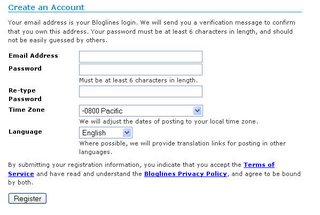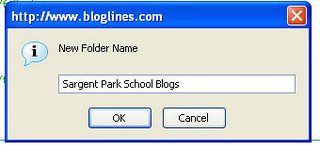Monday, October 30, 2006
Using Flickr to add pictures to your Probability Post
You do not need a flickr account to access these photos. Here is how you will find what you need.
1. Go to Flickr.
2. In the box called Find Picture type in charbeck10(this is my account) It will not work but will take you to the next page. Click on the button people and type charbeck10 again.
3. When you find my pictures go to your rooms set of game boards.
4. Find your game board.
5. Download it to your hard drive and then upload it to blogger.
6. You can now use this picture in your blogpost.
Good luck
Harbeck
Friday, October 20, 2006
Probability Assignment 2
Probability Assignment 2
Here is the second assignment you have to add to your first post. Please at the end of your first post create a title Fun and Games and complete the following questions as demonstrated in class.
Fun and Games
You and some classmates need to create a game for a booth at the school carnival. The game should be easy to make and set up. I should be fun, too, but it mustn’t take long to play. Of course the game must be fair. This means that any player would have about the same chance of winning as losing.
Explain the rules of your game. Tell why it would be fair and fun. Use Probabilty to prove your rules are fair.
Play your game 10 times. Record your results. Is it really a fair game?
Here is the Scoring Guide for this Assignment
| Instructions 5 Marks | Above Expectations Perfectly understandable Instructions | At Expectations Instructions are missing some information. | Some Effort Instructions are hard to understand | No effort Below Expectations No Instructions |
| Rules 10 Marks | Rules are fair. Probability is explained in the rules. | Rules are fair. Probability is partally explained | Rules are not fair. Probability is not explained in enough detail. | Rules are fair. No probability is involved. |
| Game Board 5 Marks | Game board or game is artistic and creative. | Game board or game has had some effort in its creation. | Game board was done at the last minute and shows little effort. | Game board or game shows a lack of pride or effort. |
| Extra 5 Marks | Above and beyond the call of duty. In all aspects of the game board, probability and clarity of instructions. | Less than above. |
Extra
Look what you can find on probability

Interactive Spinner
How do you know your game is fair.
Try these two activities using the Crazy Choices Game.
Probability Problems
Probability
(Answer ID # 0738518)
Complete.
|
| ||||
|
|
Harbeck
Wednesday, October 18, 2006
Some Probability Homework
|
| ||||
|
| ||||
|
| ||||
|
| ||||
|
| ||||
|
| ||||
|
|
Thanks for taking the time to do this work. Be sure to have 1-8 done.
If you have questions leave them in the chat box. Thanks
Monday, October 16, 2006
Images and Assignments
Part A
- Answer one of the question Groups in Full as discussed in class.
- What do all the questions have in common. What would you need to know about probability to be successful at solving them.
- Are there any common errors students might make when answering any of these questions?
- Create your own question(s) to challenge your classmates.
Here are the images you need to complete the assignment from class. I will post more info soon.


Monday, October 09, 2006
Probability
Time for Scribes
Mr. Kuropatwa introduced me to the world of Scribe Posts. It is an essential part of the Grade 8 Math Classroom. You will be expected to write one scribe post every 30 classes or about 4 a year. That doesn't sound like to much does it.
A Scribe post is
The assignment is simply to post a brief summary of what happened in class each day. A different student is responsible for the daily scribe post and they end their post by choosing the next scribe. The first scribe is a volunteer. The teacher's daily involvement is limited to updating a post called The Scribe List which is at the top of the links list in the sidebar of the class's blog.
To complete a scribe post the student must
Write a brief summary of what we learned in class today. Include enough detail so that someone who was away sick, or missed class for any other reason, can catch up on what they missed. Over the course of the semester, the scribe posts will grow into the textbook for the course; written by students for students. Remember that as each of you write your scribe posts. Ask yourself: "Is this good enough for our textbook? Would a graphic or other example(s) help illustrate what we learned?" And remember, you have a global audience, impress them.
Here are examples of good scribe posts Pythagoras Scribe One Day In Math Algebra Masterpiece
Here are some scribe posts that have made The Scribe Post Hall of Fame.
When you are done your scribe post choose another student to be the scribe and label your post scribepost.
Students Made This Rules for Blogging
Mr. Kuropatwa, a math teacher at DMCI, created this post for his students. It explains the power of blogging and blogging properly.
Blogging is a very public activity. Anything that gets posted on the internet stays there. Forever. Deleting a post simply removes it from the blog it was posted to. Copies of the post may exist scattered all over the internet. I have come across posts from my students on blogs as far away as Sweden! That is why we are being so careful to respect your privacy and using first names only. We do not use pictures of ourselves. If you really want a graphic image associated with your posting use an avatar -- a picture of something that represents you but IS NOT of you.
Two teachers in the U.S.A. worked with their classes to come up with a list of guidelines for student bloggers.
One of them, Bud Hunt, has these suggestions, among others:
- Students using blogs are expected to treat blogspaces as classroom spaces. Speech that is inappropriate for class is not appropriate for our blog. While we encourage you to engage in debate and conversation with other bloggers, we also expect that you will conduct yourself in a manner reflective of a representative of this school.
- Never EVER EVER give out or record personal information on our blog. Our blog exists as a public space on the Internet. Don’t share anything that you don’t want the world to know. For your safety, be careful what you say, too. Don’t give out your phone number or home address. This is particularly important to remember if you have a personal online journal or blog elsewhere.
- Again, your blog is a public space. And if you put it on the Internet, odds are really good that it will stay on the Internet. Always. That means ten years from now when you are looking for a job, it might be possible for an employer to discover some really hateful and immature things you said when you were younger and more prone to foolish things. Be sure that anything you write you are proud of. It can come back to haunt you if you don’t.
- Never link to something you haven’t read. While it isn’t your job to police the Internet, when you link to something, you should make sure it is something that you really want to be associated with. If a link contains material that might be creepy or make some people uncomfortable, you should probably try a different source.
Another teacher, Steve Lazar, developed a set of guidelines in consultation with his students. You can read them here.
Look over the guidelines and add the ones you like in the comments section below this post.
These are important guidelines and rules for blogging. Use this space wisely
Measures of Central Tendency
Here is an excellent page to help you complete the Quiz. Read it well some great information is found here.
Can you find any other sites out there that would help us review Measures of Central Tendency?
One of the goals of blogging is that school never has to be done. Practice these questions on your own and find links if you wish. Happy MMMing!!
Mr. Harbeck
Thursday, October 05, 2006
Making a Personal Learning Network
Here is a 7 minute screencast that shows you how to set up a Bloglines Account. After you watch it please start to make your own Personal Learning Network.
You need to create a Bloglines Account. Bloglines is a service that collects all the new posts from blogs that you subscribe too.

At this page please use your email address and a passwork youwill not forget. Change the time to 0600 central time. Now click register. This is the screen you should see.

In your email respond to the bloglines email by clicking on the link.
 I would suggest skipping the next page and clicking on
I would suggest skipping the next page and clicking onTo start your Personal Learning Network I would like you to subscribe to the 4 math classes and the Sargent Park Math Hub. This will keep you up to date when other students create posts that you would like to view and comment on. Commenting on each others work is the most important aspect of blogging.
In the window
 paste the following url
paste the following url
Use the following feed to subscribe (click the box in the right corner).
 Choose new folder
Choose new folder save as
save as now click subscribe.
now click subscribe.817math.blogspot.com
841math.blogspot.com
873math.blogspot.com
Click add in the upper left hand corner.

Paste the address in the subscribe box then make sure you put this new blog in the following folder
 Click subscribe and do the rest of the class sites.
Click subscribe and do the rest of the class sites.These 5 blogs will be the start to your Personal Learning network. Next stop other sites that will help with your personal learning.
But that is another post!!!
